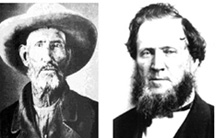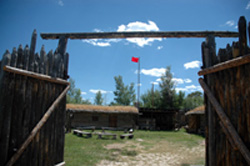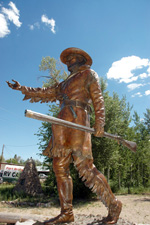Pioneer Days Remembrance – Fort Bridger
In the vast wilderness of the Rocky Mountains, Fort Bridger was the gateway to the westward expansion during the mid-1800s. Between 1847- 1869, over 70,000 Mormon emigrants had traveled over the Mormon Trail to the Salt Lake Valley.
LeRoy W. Hooton, Jr.
August 20, 2010
Left to right: Jim Bridger and Brigham Young make history in the settlement of the west.

On June 28, 1847 Brigham Young encountered mountain man Jim Bridger near his trading post (Fort Bridger) located about 120 miles east of the Mormon pioneers' Great Salt Lake Valley destination. Brigham Young was anxious to learn as much as possible about the little known Great Basin. He ordered the wagon masters to set up camp and spent the afternoon into the evening quizzing Jim Bridger. Pioneer Erastus Snow was privy to their conversation and wrote in his journal that Bridger told President Young that he considered it imprudent to bring a large population into the Great Basin and he'd “give $1,000 for a bushel of corn raised in the basin.” According to Snow, Brigham Young replied, “Wait a little, and we will show you.”
This meeting of the mountain man and the President of the Church of Jesus Christ of Latter Day Saints (Mormons) would not be their last. Several years later, their paths would again cross, this time over Fort Bridger.
Jim Bridger spent nearly all of his adult life wandering in the Rocky Mountains hunting and trapping for his livelihood. He and a band of hunters and trappers would become known as “mountain men.” He had been given (disputed) credit as the first white man to see the Great Salt Lake in 1824 and among others in a party, first to see the wonders of Yellowstone.
In 1843, Jim Bridger built a trading post fitted with a blacksmith shop at a strategic location in the valley of Black's Fork west of Ham's Fork of the Green River in what is now southwestern Wyoming. He and his partner Louis Vasquez hoped to make a living by servicing regional traders and the multitude of coming emigrants traveling west. The trading post's location had access to the Oregon, California and the Mormon Trails, providing business opportunities for the co-owners and a vital stopping off point for travelers.
A year before the Brigham Young – Jim Bridger meeting in 1847, the trading post was described as “...two or three miserable log cabins, rudely constructed, and bearing but a faint resemblance to habitable houses,” by Edwin Bryant a member of a party en route to California. On the other hand the site received more favorable comments as “handsome...with fine quality grass. The water of the stream is cold and pure, and abounds in spotted mountain trout and a variety of other small fish.” Apparently, the post had not changed much during the intervening year, when Orson Pratt on July 7, 1847 described the trading post: “...Bridger's post consists of two adjoining log houses, dirt roofs, and a small picket yard of logs set in the ground, and about eight-feet high.
|
Between 1850 and 1861, Fort Bridger was included in the Territory of Utah (Utah Territory), which consisted of the current state of Utah, most of the state of Nevada and portions of western Colorado and southwestern Wyoming. The Utah Territory Legislature created Green River County in southwestern Wyoming in 1854. Brigham Young was both the spiritual and ecclesiastical leader of the Utah Territory.
In 1853, the paths of Brigham Young and Jim Bridger crossed for a second time when Governor Young received reports that ammunition and liquor were being sold to the Indians near the fort. Under federal law and his authority as a federal Indian agent, Brigham Young dispatched Utah Territory militia (militia) to Fort Bridger. Forewarned, Jim Bridger escaped before being arrested and did not return until 1855. The fort was no longer used as a trading post. The militia built another supply station named Fort Supply 12-miles to the southwest of Fort Bridger to service the Mormon emigrants. The following year, Brigham Young ordered militia reinforcements to guard Fort Bridger and the Green River ferries. A stone wall was built around the fort, of which a remnant is still visible today.
The fort remained under militia control until 1855 when Bridger sold the fort to an officer of the militia representing the Utah Territory for $8,000 with $4,000 down and the remainder paid fifteen months later. Two years later, the fort again became embroiled in conflict when General Johnson, planned to use it as a staging area for his military forces to enter into the Utah Territory for the purpose of subduing allegations of Mormon seditious activities (The Utah War 1857-58). Both the Mormon Fort Supply and Fort Bridger were torched leaving Johnson's army with no shelter to endure the harsh winter of 1857. The war was short-lived, and as part of the peace negotiations, Brigham Young agreed to pay the remaining $4,000 to Bridger; however, Congress rejected his claim that the Utah Territory owned the fort. Subsequently, it became the property of the U.S. government. Until 1890, the fort was used intermittently as a military base; thereafter, it was abandoned by the U.S. Army and many of the building were sold to private interests. In 1933, the property was dedicated as a Wyoming Historic Landmark and Museum.
In 1861, the Utah Territory's boundary was adjusted, eliminating southwestern Wyoming, including Fort Bridger from its jurisdiction.
The Utah Territory continued to grow under the leadership of Brigham Young. The Mormons perfected the practice of irrigation and were able to “make the desert blossom as a rose.” The population of the Utah Territory was approximately 170,000 when he died in Salt Lake City on August 29, 1877. Jim Bridger, after another stint as an army guide, settled on a farm in Dallas, Missouri where he died in 1881.
There has been much speculation about the apparent acrimony between Brigham Young and Jim Bridger. Perhaps Bridger resented the newcomers to the frontier dominating the region. It has been said that Brigham Young believed that Bridger was stirring up the Indians to raid Mormon towns; or that he was spying on the Mormons and reporting to Washington. There is even speculation that they disliked each other after their first meeting in 1847. Notwithstanding, clearly after Brigham Young issued a warrant for his arrest and impounded the fort, Bridger became an adversary. He acted as chief guide for Johnson's army and relentlessly lobbied Congress against the Mormons. His lobbying is credited with Congress adjusting the Utah Territory's boundary in 1861, which freed Bridger's homeland from its governance.
|
Jim Bridger and the fort with his namesake are part of Utah's history. As we celebrate our pioneer heritage, the Fort Bridger site is worthy of our attention. Until the trans-continental railroad was completed in 1869, over 70,000 Mormons traveled overland on the Mormon Trail, passing near Fort Bridger en route to the Salt Lake Valley. Today, as noted in the Fort Bridger Historic Site brochure, the site provides visual images of the trading post, which was “...one of the main hubs of westward expansion used by mountain men and Indians to emigrants and Mormon pioneers, the U.S. Army, the Pony Express, the Overland Stage and the Union Pacific Railroad. If it happened in the opening of the American West, it affected, or was effected by Fort Bridger.”
Select references:
Mormon Pioneer Trail. National Park Service, Bureau of Land Management, U.S. Department of the Interior
Fort Bridger, A Brief History, by R. S. Ellison
Fort Bridger Historic Site, Wyoming State Parks, Historic Sites & Trails – Museum, displays, films and replicas

